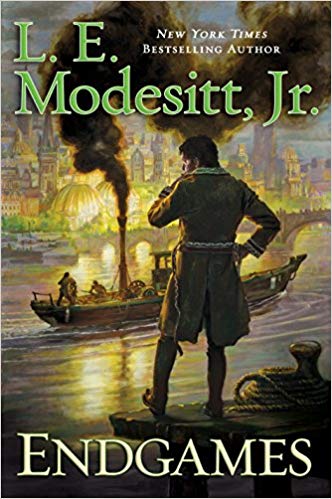 Endgames (Imager Portfolio #12) by L.E. Modesitt Jr.
Endgames (Imager Portfolio #12) by L.E. Modesitt Jr. Format: eARC
Source: supplied by publisher via Edelweiss
Formats available: hardcover, ebook, audiobook
Genres: epic fantasy, fantasy
Series: Imager Portfolio #12
Pages: 576
Published by Tor Books on February 5, 2019
Purchasing Info: Author's Website, Publisher's Website, Amazon, Barnes & Noble, Kobo, Bookshop.org
Goodreads
Endgames is the twelfth novel in L. E. Modesitt, Jr's, New York Times bestselling epic fantasy series the Imager Portfolio, and the third book in the story arc that began with Treachery's Tools and Assassin's Price.
Solidar is in chaos.
Charyn, the young and untested ruler of Solidar, has survived assassination, and he struggles to gain control of a realm in the grip of social upheaval, war, and rioting. Solidar cannot be allowed to slide into social and political turmoil that will leave the High Holders with their ancient power and privilege, and the common people with nothing.
But the stakes are even higher than he realizes.
The Imager Portfolio#1 Imager / #2 Imager's Challenge / #3 Imager's Intrigue / #4 Scholar / #5 Princeps / #6 Imager's Battalion / #7 Antiagon Fire / #8 Rex Regis / #9 Madness in Solidar / #10 Treachery's Tools / #11 Assassin's Price / #12 Endgames
Other series by L. E. Modesitt, Jr.The Saga of RecluceThe Corean ChroniclesThe Spellsong CycleThe Ghost BooksThe Ecolitan Matter
My Review:
There’s a saying about war being diplomacy by other means. Endgames feels like a story about politics being civil war by other means. Alternatively, one could extend the metaphor that Lois McMaster Bujold proposed of SF as fantasy of political agency and expand that to speculative fiction, which includes fantasy, as, well, fantasy of political agency. Because most of the Imager Portfolio in general, and this book in particular, is certainly all about the politics.
However, unlike the traditional epic fantasy, neither this book nor this series focuses on the adventures of a “chosened one”. Instead, the protagonists of this series often feel, particularly from their own perspectives, more like the “stuck one”. The person who finds themselves the linchpin of epic events they did not plan on. And they would generally rather that the cup had passed to someone else – at least until they decide that whoever might have been stuck into their position instead would have done even worse.
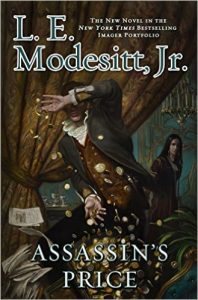 The events in Endgames directly follow the events in the previous book, Assassin’s Price. There was an assassin in that book, and the person who was assassinated was the Rex. Now his oldest son, Charyn, is Rex, trying to stay alive in the midst of the continuing chaos.
The events in Endgames directly follow the events in the previous book, Assassin’s Price. There was an assassin in that book, and the person who was assassinated was the Rex. Now his oldest son, Charyn, is Rex, trying to stay alive in the midst of the continuing chaos.
Unlike the previous heroes in this series, Charyn did expect to be in the position he now occupies. Someday. Eventually. Just not quite so soon, or in the midst of quite so big a crisis. As the saying goes, “the king is dead, long live the king.” But when you’re the second king in that phrase, and not the first one, if you love your father – and Charyn did – you hope that when the first king dies it occurs peacefully, in his bed, after a long and fruitful life. Not in his prime, at the hands of an assassin.
An assassin who is now gunning for you. And who may be much closer than you’d like to think.
So Charyn is busy in this book. First, he is shoring up his internal defenses, trying to stay one step ahead of whoever is trying to kill him. Second, he is attempting to guide his country into the future. A future that he alone envisions, and one that will be much different from its past.
Not that the future won’t come whether Charyn guides things or not, but it’s a question of what that future will be. The High Holders, who are the hereditary aristocracy and the major landholders, want the future to look like the past. A past where they were on top of the heap and could grind anyone they wanted under their heel.
But Solidar is changing. The Factors, who are the business class, are amassing greater and greater power – mostly by getting richer and richer. But it’s happening because Solidar is going through its version of an industrial revolution and power is flowing towards them and away from the aristocracy – as occurred in Great Britain during its Industrial Revolution.
Charyn recognizes this shift in the tide, while at the same time seeing the need to regulate some business practices for “the greater good” – a greater good that is explicitly NOT the good of the aristocracy, but the good of Solidar as a whole.
He’s aiming toward a compromise that serves everyone. If he lives long enough to bring it to fruition. If he survives the dagger aimed at his heart from much, much closer than he imagined.
Escape Reading A: I read this in a day. All 576 pages of it. And pretty much immediately upon receipt four long months ago. I’ll also confess that I had to wipe away a tear at the end. The only reason I’m not grading it higher is that it would be impossible for a new reader to get into the series at this point. As the title implies, this is an endpoint for the series. Possibly THE endpoint, but when asked the author said that he was still deciding. I hope he decides in favor of MORE IMAGERS!
 But Endgames is certainly the ending of this middle sequence of the series. Interested readers can begin the Imager Portfolio at one of three places. Either the first published book of the series, Imager, the first book of the internal chronology of the series in Scholar, or the first book of this subseries, Madness in Solidar, which is the middle sequence in the internal chronology.
But Endgames is certainly the ending of this middle sequence of the series. Interested readers can begin the Imager Portfolio at one of three places. Either the first published book of the series, Imager, the first book of the internal chronology of the series in Scholar, or the first book of this subseries, Madness in Solidar, which is the middle sequence in the internal chronology.
Endgames is a very political story. That’s true for much of this series, but particularly this subseries in general and this book in it in particular. Charyn is caught between a rock and several hard, sharp and pointy places. We see the story from inside his head, so we understand just where he’s coming from and just how difficult a position he is in at all times.
Everyone has an agenda. Including, admittedly, Charyn himself. But each of the factions that Charyn has to juggle has an agenda that benefits them alone, where Charyn’s agenda is a sometimes desperate attempt to do what’s best for everyone. Or at least what is a reasonable compromise for everyone.
Most of the factions do not want to compromise and their feet will have to be held to the fire – at least metaphorically – in order to make that happen. Charyn is fortunate that the imagers are on his side and perfectly capable of providing that fire – literally if necessary.
The contrast between events as directed by Charyn and current events in the US is also a stark one. As the person at the top of the pyramid Charyn could arrange the situation to benefit himself and his allies only. The laws of the time allow that possibility. But it is not good governance. The best course involves compromises between a lot of people whose interests do not seem to coincide. That he manages to make it happen in spite of each faction’s self-interest is a joy to watch – even though the personal cost is incredibly high.
If you like epic fantasy with lots of politics, this series could be your jam. It certainly is mine!

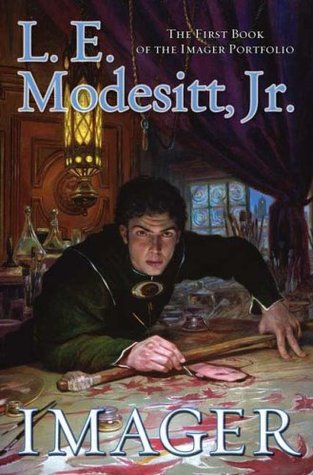 Imager (Imager Portfolio, #1) by
Imager (Imager Portfolio, #1) by 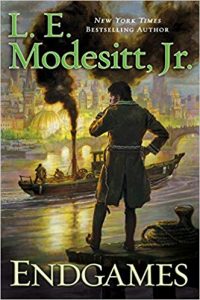 This was a re-read for me. I first read Imager when it originally came out in 2009 because the cataloger in the next office was cataloging it and said it looked good. He was right. In fact, he was so right that I continued to read the series over the next decade. I finished the current final book in the series,
This was a re-read for me. I first read Imager when it originally came out in 2009 because the cataloger in the next office was cataloging it and said it looked good. He was right. In fact, he was so right that I continued to read the series over the next decade. I finished the current final book in the series, 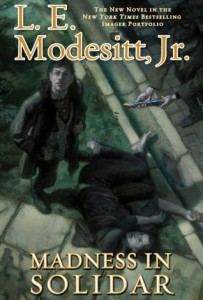 Within the opening chapters of Imager, I was both pleased to learn that the earlier history of Terahnar, and the country of Solidar, was anticipated from the beginning. Rhenn tours the Council Chateau with his father, and sees portraits of both Rex Regis, the man who becomes Rex in the Quaeryt Quintet, and Rex Defou, the Rex who is overthrown in
Within the opening chapters of Imager, I was both pleased to learn that the earlier history of Terahnar, and the country of Solidar, was anticipated from the beginning. Rhenn tours the Council Chateau with his father, and sees portraits of both Rex Regis, the man who becomes Rex in the Quaeryt Quintet, and Rex Defou, the Rex who is overthrown in 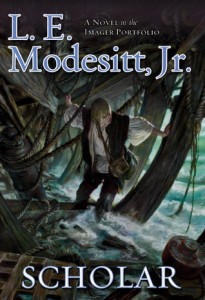 As much as I wanted to slap his mother silly, it’s Rhenn’s story that I came to see. Or rather hear. It does feel like it fits in its proper place in this history, and follows very well after finishing Endgames.
As much as I wanted to slap his mother silly, it’s Rhenn’s story that I came to see. Or rather hear. It does feel like it fits in its proper place in this history, and follows very well after finishing Endgames.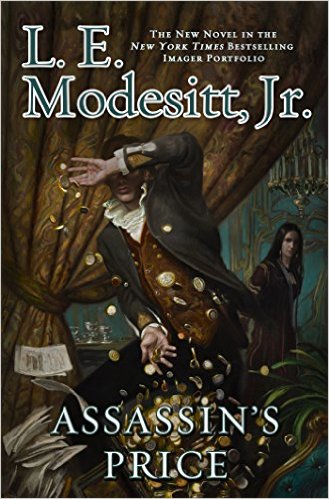 Assassin's Price (Imager Portfolio, #11) by
Assassin's Price (Imager Portfolio, #11) by 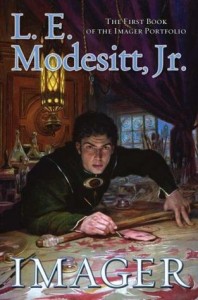 After two book failures, I gave into temptation and picked up Assassin’s Price about a month before I’m scheduled to review it. And I’m very glad I did. Just like all of the books in the
After two book failures, I gave into temptation and picked up Assassin’s Price about a month before I’m scheduled to review it. And I’m very glad I did. Just like all of the books in the  Although this is part of the Imager Portfolio, the imagers themselves do not feature greatly in it. In this story, the imagers are doing what their founder, Quaeryt envisioned, not being a power themselves but keeping the balance between all the factions, between the Rex, the high holders and the factors. And as Quaeryt envisioned and Alastar exemplified, the way they do that best is by keeping good Rexes alive and functioning.
Although this is part of the Imager Portfolio, the imagers themselves do not feature greatly in it. In this story, the imagers are doing what their founder, Quaeryt envisioned, not being a power themselves but keeping the balance between all the factions, between the Rex, the high holders and the factors. And as Quaeryt envisioned and Alastar exemplified, the way they do that best is by keeping good Rexes alive and functioning.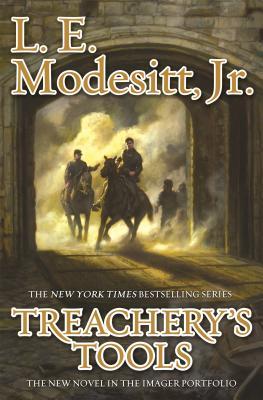 Treachery's Tools (Imager Portfolio, #10) by
Treachery's Tools (Imager Portfolio, #10) by